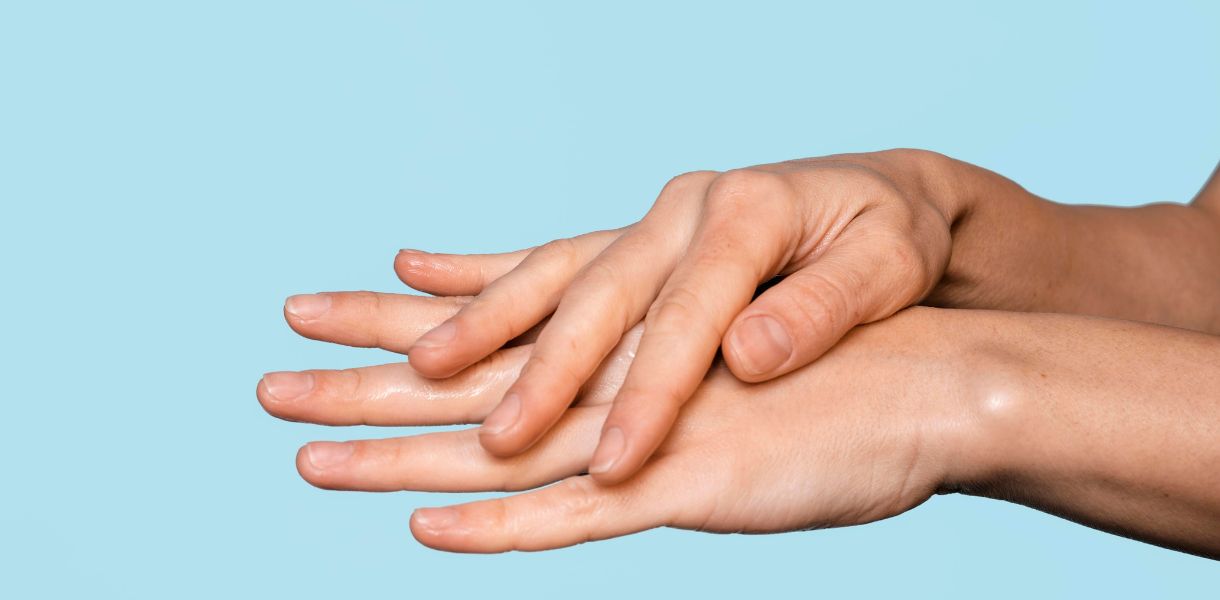Introduction: Understanding Skin Cancer on Fingers
While skin cancer on the fingers is not the most common type of skin cancer, it is worth noting. Because of the frequency of exposure to sunlight on the hands and fingers, exposure to (UV) rays can damage skin cells over time by engaging in some of its reproduction cycles. Because of this continued exposure, in fact, the fingers make one of the most vulnerable sites for skin cancer to develop. Early detection of warning signs can alleviate further complications and improve the likelihood of recovery.
Common Causes of Cracked or Damaged Finger Skin
Cracked or dry fingers are often associated with dryness, frequent handwashing, or exposure to harsh chemicals, but they are not a sign of skin cancer. Ongoing skin damage can increase its sensitivity to ultraviolet (UV) light.
The following is a list of the more typical, non-cancerous causes:
- Dry skin: Washing your hands frequently or using alcohol-based sanitisers removes the skin’s natural oils, which help protect it from drying out.
- Eczema or psoriasis: Eczema or psoriasis causes inflamed, scaly, or cracked fingers.
- Fungal infections: a ringworm infection on the hands may look like patches of dry, cracked skin.
- Vitamin deficiencies:deficiencies in vitamin E and/or vitamin C — weaken the skin’s defences and healing capabilities, leading to cracked hands.
- Diabetes: poor circulation in the hands and feet leads to dry skin and delayed healing.
Knowledge of these possible conditions help you to exclude routine causes before skin cancer is suspected.
How Skin Cancer Can Develop on Fingers
Skin cancer on fingers usually develops when DNA in skin cells is damaged by UV radiation. Over time, those skin cells will begin to multiply abnormally, forming a visible lesion or growth.
Three primary types of skin cancer may develop on fingers:
- Basal Cell Carcinoma (BCC): The most common skin cancer, BCC appears as an unusual pearly bump or sore that does not heal.
- Squamous Cell Carcinoma (SCC): Usually appears on the skin as rough, red, or scaly patches that often bleed or crust.
- Melanoma: Melanoma is rare and is a more dangerous type of cancer; it may resemble a dark mole or a dark streak under the fingernail.
Signs & Symptoms
It is important to detect early symptoms of skin cancer on the fingers so that, if treatment is necessary, it can be provided quickly. Signs and symptoms to look for include:
- Sores or open wounds that do not heal.
- Raised or rough areas of the skin that bleed.
- A pearly, semi-translucent, or waxy bump.
- A newly raised or changing mole on the skin or under the fingernail.
- Discoloration or dark bands under the fingernail.
If a lesion or bump continues after a month, you should first reach out to your doctor to see a dermatologist sooner.
When to See a Doctor
If cracked or sore fingers do not improve after regular moisturizing, or you observe new growth, lesion, or mole changes, seek medical attention. Individuals with lighter skin, frequent sun exposure, or with a previous history of skin cancer should have regular skin checks. Early detection leads to easier treatment and improved prognosis.
Diagnosis and Treatment Options
A doctor can identify skin cancer on fingers through a visual assessment or skin biopsy. If skin cancer is diagnosed, treatment will depend on cancer type and stage:
- Cryotherapy: freezing small lesions with liquid nitrogen
- Surgical excision: removing cancerous tissue or skin with a small margin of healthy skill
- Topical therapy or radiation therapy: used for non-melanoma skin cancers.
- Targeted therapy and immunotherapy: used in cases of advanced melanoma skin cancer
After therapies have taken place, regular follow-up visits can help prevent recurrence.
Also Read : How To Take Care Of Your Skin In The Fall
Prevention Tips to Protect Your Fingers
To prevent the risk of skin cancer on fingers, preventive care is the best way to protect. You can take simple steps to reduce your risks daily:
- Every day, apply sunscreen to your hands, even on cloudy days.
- Consider gloves while driving, gardening, or cleaning with chemicals.
- Don’t use tanning beds or spend too long in the sun.
- Consider a good moisturizer to keep your skin hydrated.
- Eat a balanced diet rich in antioxidants, vitamins, and other nutrients.
Conclusion
When caught early, finger skin cancers are preventable and treatable. You can reduce your risk of skin cancer by paying attention to any unusual changes in your skin and by protecting your hands from UV exposure. If you notice persistent sores, asymmetrical moles, or bleeding associated with remarkable changes in fingernail color, you should visit your dermatologist as soon as possible. Good habits
FAQs
Can skin cancer develop on fingers?
Yes. Fingers are frequently subject to sunlight and UV radiation, which can lead to skin cancer over time.
What does skin cancer look like on fingers?
Skin cancer on the fingers may look like a scaly patch, a sore that doesn’t heal, a pearly bump, or a dark streak under the nail.
Is every cracked finger cancer?
No. Most cracked fingers are caused by dry skin or skin conditions like eczema or psoriasis. However, if you have a sore that won’t heal, bleeding, or bathroom sores, you need to seek medical help.
What is the treatment for skin cancer on the fingers?
Treatment may include surgery to remove it, cryotherapy or topical therapies, depending on the type and stage of cancer.
How can you prevent skin cancer on your fingers?
Wear sunscreen, avoid prolonged sun exposure, use gloves when in the sun, and continue regular skin assessments.
Also Read : Skin Ageing: Chronoaging And Photoaging

